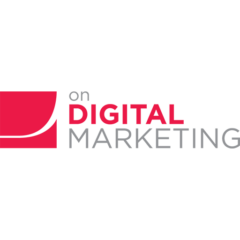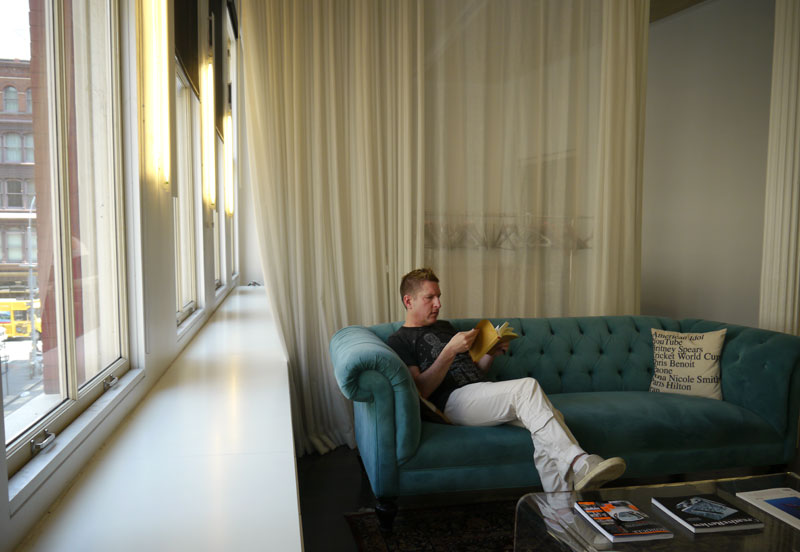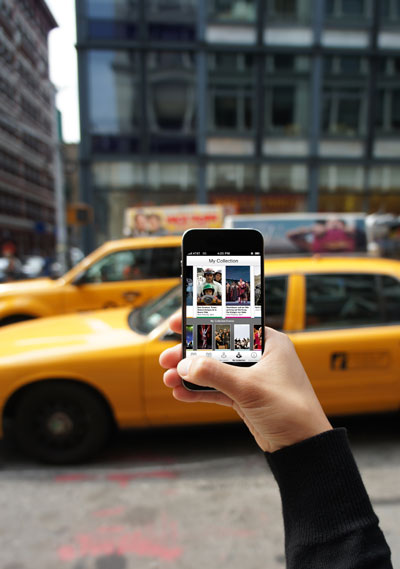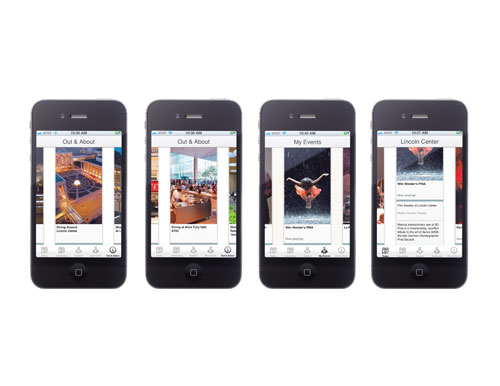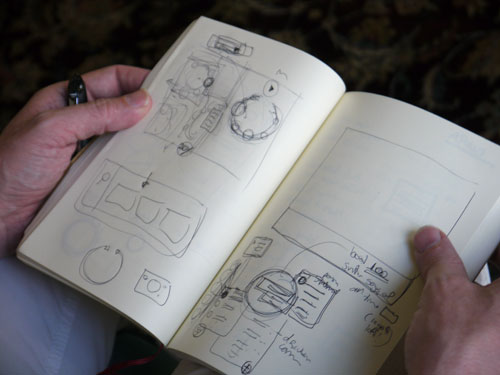Duane Bray sketching out ideas at IDEO’s office in New York City in lower Manhattan
Note: This is an interview we originally did for Smashing Magazine as part of the “How I Work” series.
What follows is an extended outtake from the interview from the editing floor. Hope you enjoy – and a huge thank you to Duane Bray.
IDEO is consistently listed as one of the world’s most innovative design companies due to its uncanny ability to constantly come up with great ideas for its clients. Duane Bray is a Partner at the firm and has headed up IDEO’s digital business from its New York City office. And like all IDEOers you meet, Duane Bray is unfailingly nice with a soft well-spoken voice. He reminds you of the kid in the back of Algebra class doodling away during lecture and still acing the tests.
We recently sat down with Duane over a couple sessions to get his thoughts on Agile Development, how you too can gather great user insights, tips for prototyping digital projects with clients, and why he still sketches interfaces out on paper.
How did you get started in digital?
Duane: My background is in interactive design, so I’ve been designing stuff with pixels for as long as I can remember. I started at IDEO back in the day when people thought CD-ROMS were going to rule the world. I moved beyond multi-media into all sorts of things and one of the first was when IDEO was designing the interface for a blood gas analyzer for open heart surgery and it was like “whoa, this is where good design really matters because it literally is life or death. In more recent years, I’ve played more of a role in shaping and grow a lot of our digital work from our New York office. I do a lot of work right now in education as well.
What has you excited about digital work these days?
Duane: I’m particularly excited about the movement aware from standards based specifications towards real stuff. For us, we’ve been doing a lot more experimentation around Agile Development processes and pairing up designers and developers side by side throughout the process from day one. The last thing you want to do is hire a designer who is really talented at conceptual thinking and say “Okay, now you’re going to spend six weeks documenting everything with InDesign for the thing you did.”
What’s funny though is when you have a designer working with a developer on weekly builds, all that stuff still gets done. But from the designer’s perspective they are constantly making. We’ve found our teams to be super excited to be working in this way.
Certainly, we’re not the first to discover Agile but it’s made a big difference in our culture because we want people to get their ideas as real and tangible as soon as possible.
What’s the good and bad about creating digital experiences in your opinion?
Duane: It’s amazing how inspirational people in the world are just by doing the things they do and they don’t even realize it. You learn so much amazing stuff every time. There is nothing more interesting than human behavior and translating that into things we should be making.
Of course, seeing things come to life and getting better and better is really exciting.
The part of the process that can be tough is honing features down and having to leave them behind. That’s always the bummer because you think, “Dang, this needs to be out there!”
Mobile Streetside in New York City
Where do you see digital going?
Duane: Well, you don’t have to cast your crystal ball very far forward to say that mobile and tablet is important and to understand those experiences. But I think more and more also understanding multi-channel experiences is really important. Meaning you should have a point of view in your design experience about what the difference might be for a smartphone version, tablet version and web version. What is the flow like as you go from one to the next?
The other thing is thinking a bit more holistically around how experiences relate to and feed off each other. The days of designing for purely one medium is shifting significantly. Expectations of consumers is shifting quickly as well.
And the sophistication of clients around all these touchpoints is growing as well. It’s really an amazing time to be in this field.
Given these interfaces and experiences, how would say all this fits within the Responsive Web Design philosophy?
Duane: I think it depends on the experience. In some cases sure you can have mobile web scaling up to the browser. But I also think the needs can be different when people are changing platforms. And so I would recommend that designers first ask, “how do I intend people to use each of these experiences?”
“Are there components more optimized for one experience?” – like time dependency, things going on around them, features like messages or alerts.
I would think it a sad world if everything was just designed to scale from one platform to the next without thinking whether or not there needed to be a different experience in the use.
Walk us through you might tackle a tough problem like loyalty for a client say in the financial sector?
Duane: Well, how do we define loyalty for someone in the financial sector?
- Are we talking about loyalty in terms of building ongoing relationships?
- Ongoing revenue streams?
- And can we be inspired by solutions out in the world in other contexts?
So, we looked at two other examples of loyalty. One was talking to a marriage counselor – so, when you talk about loyalty in context of a relationship like that, what are some of the principles or best practices that exist there?
The other one was to interview an Army recruiter and ask them how do they talk about loyalty in the context of serving your country to really explore the question from different perspectives.
So, at the early stage we’re looking to be very, very expansive.
How does IDEO go about getting big breakthrough insights?
Duane: Well, for a lot of our clients they come to us with these sort of vague questions and they want us to help them figure that out. So, we want to start off by making sure we’re a bit exploratory – and that involves going out and being inspired by behaviors.
For example, there might be a question around new forms of video consumption online. We want to go out and find people that are representative of some extreme form of behavior. This helps us get inspired and further shapes our strategy.
One woman we found has two computers at work. One is displaying her work and the other one is displaying reality television. She needs both streams to do her job. The interesting thing is you can almost hit pause and ask her what’s going with the show and with her work and she can answer both.
So, it starts to suggest what are some of the interesting forms of literacy that are coming through our digital tools? And how might we design for this? Are there new mental models we haven’t thought about before rather than going with industry standards?
IDEO is famous for “thinking with your hands” via prototypes – how do you transfer this over to digital?
Duane: For me I don’t see any distinction in how IDEO designs digital products compared to our other products. We’re still going to get out there and be inspired by what’s going on in the world.
We always start our projects with some sort of investigation into what are people doing and how it impacts how they’re going to engage. Specifically, how does human behavior impact the business objectives?
What’s this discovery process look like?
Duane: Sometimes, we’ll prototype something in the browser or on mobile to test some of these concepts out. We’ll also play around with paper prototypes because it’s an appropriate way to get client input.
But I like to find ways to disrupt the conversation when we’re talking with consumers.
For example, if something is very polished consumers will feel they have to say they like it because it’s polished. So sometimes having hand-sketches along with something on an iPad we’re able to get very nice conversations going.
Prototyping is about blending that low fidelity and high fidelity process and blending our thinking as we go along.
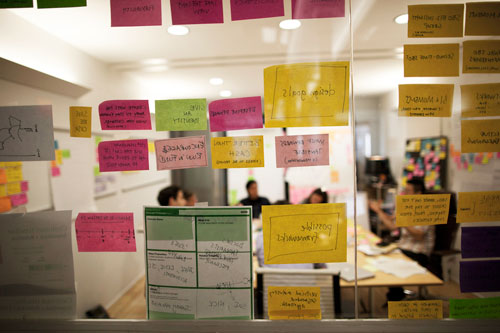
The infamous Post-It notes you find everywhere at IDEO
How would you make a case to a Smashing Magazine reader for adopting a prototyping process with their clients?
Duane: Well, the client is going to be in a better position to make more informed decisions because they are seeing things that are real. I would also argue that it isn’t a massive investment anyway and there is a better pay-off down the road because you’re getting more real (tangible) early on – which means you’re going to get better input from users.
Imagine not going through that process: doing a bunch of sketches, building out a spec document, a developer builds it, you test it and people hate it.
At that point there has been such a huge investment in producing that thing. So there is actually a lot of emotional attachment now and it’s either going to be financially impossible to correct it or people will be too wedded to the idea and it’s going to be impossible to change.
How do you show these prototypes?
Duane: We do a lot of live work. We’ll recruit a panel of end-users. Particuarly in the early stages when we’re looking for inspiration, we’ll want to be in their (the users’) context. So instead of bringing them into a focus group, we might go into their homes or offices and observe them. We’ll also put stuff up on the web and blast out an SMS message and ask people to interact so we can get a more broad approach as well.
Sometimes we’ll do a hybrid of both and have our developers do quick builds and mock-ups and then go back out into the field to get more insights with a select group.
We want to know less about what percentage of people clicked on this or dropped off and more about their process of going through and using that experience. What are the specific things that are barriers and why?
At some point, when we have a much more robust build then we’ll push it out to more people. So there is definitely an interim phase. We tend to start high touch and stay that way for awhile. We’re looking for finding the emotions around why people engage or why they don’t. If we understand those it becomes a lot more powerful in how we tune the tools.
What’s your experience been with Agile Development processes?
Duane: One of the things we’ve found when we’re working in an Agile process, is that we can actually be incredibly fast.
To give you an example, we did a project here in New York for Lincoln Center which was their first iPhone app and we ran it as an Agile process. We went from kick-off to an app in the iTunes store in eight weeks. That’s concept, design, and build (and I wouldn’t want to claim we can do every project on that timeline). But we had an amazing client that was able to make decisions very quickly, so we had a fast turnaround time there.
But again, it was because we were getting very real, very fast.
IDEO’s iOS app for Lincoln Center
Can you give us a step by step breakdown for creating this app in only eight weeks using Agile?
Duane: Sure – First, we spent half a day with our designers and developers at Lincoln Center’s campus and in advance we created briefs about what an app could look like around different themes. We broke up into teams and every group had to go and interview people at Lincoln Center and talk to them about the theme and do a tour themselves. We had clipboards of iPhone screen print outs and they (the teams) had to sketch an experience and get feedback – all in four hours. It was a great way to get immersed: we talked to security guards, out of town tourists, locals who would hang out there, people at the information desk and we got a ton of insights.
So we had all these amazing stories to go back and work with for honing our hypothesis on what this experience should be and we started building it. We did a detailed sketch session, prioritized the feature set, mapped out the flow, did some wireframes and then did a planning session with our development team. The project was so fast, there were literally just screenshots on the iPhone to simulate the flow. We were sharing it with people quickly and got to the stage where there was a build a week.
But the reality about that process is that you couldn’t do Waterfall in eight weeks. I would say it’s more efficient than an old-fashioned step process.
Agile has been around for 20+ years and we’re certainly not the first to discover it but now it’s finally getting traction. Designers and developers want to spend time making stuff and getting it out there and this process is all about that.
What habits or hang-ups do you see in great web designers and developers?
Duane: Well, one of the things I think that is probably the most challenging for working in this more iterative rapid fire way is the ability to be more open and transparent with the work that you’re doing. Sometimes as designers we want to spend some time crafting hiding in a corner and sketching and then do the “ta-da!”. But some of this new way of working requires us to move beyond that.
One of the things I’ve been thinking about is how do you encourage greater transparency of work that’s in progress? We’ve been prototyping with tools like Flow Doc that allows for conversation to sit around the workflow. That is particularly important, if we’re talking about getting stuff out there really early. These are the certain things that aren’t to the nature to how a designer is trained.
There is also this thing about great developers having curiosity. Being curious about the end user you’re designing for and involving the developers in that process for insights. Being able to imagine if they’ll use the thing you’re making.
Some folks are really natural at that and in other cases it takes a lot of work. But I think that’s where we’re going – working off of blended teams with people of different skill sets.
Any tips on how a small shop can get similar disruptive insights like IDEO does?
Duane: As designers it’s easy to get blinders on because we know what we know and it’s easy to get caught up in it. So, take some time to start over like you’ve never done this before. Sign up for some new tools and track your progress and behavior as an end user. There is something about just getting out to find inspiration. Look for stuff going on whether it’s a related conference or just inviting in some experts to talk over wine and cheese at your office.
Even a small shop can reach out to friends of friends and watch them interact with some early prototypes or simply have a conversation. Say you’ll buy them drinks every other week and just show them stuff and see what you can learn from building that into your process.
One thing I do is have a screen on my phone that is just apps I would never normally download. So, we might be doing a project around say video and I’ll go try every app out there and use this as a great way to learn. Projects are often an opportunity to dive deeper into a subject area you’re not necessarily interested in but you could be super inspired by it.
Now how do you capture those inspirations?
Duane: I usually have my notebook open as I’m using all these apps and I’m sketching out ideas and patterns. You start to get a feel for trends and think about different ways to accomplish the same task.
Duane’s sketchbook with scribbles for different interactions
Where and how do you do your best work and not get burned out?
Duane: I usually get away from my desk. I’ll go sit up front on the couch with my laptop and my sketchbook. I force myself to move around. If you just sit at your desk you’re inclined to get into bad habits because everything is sitting around you. Some people have the zero inbox but I have 35,000 messages, so I just use the search box in email (laughs).
I’m someone who runs on intuition and not organizational processes. I have a thousand sticky notes on my desk.
But I’m pretty rigid about taking weekends off. I wasn’t always this way but I’ve learned that by being open to being inspired by stuff that has nothing to do with what I’m working on is really important.
Otherwise, you’re not grounded enough to bring something original to the table.
Duane’s Sketchbook
Generalist or Specialist?
Duane: The nature of the problems we solve are so broad that I usually put myself more on the Generalist side. At IDEO we’re big fans of the “T-Shaped” people model, which means you have lot’s of different interests and talents but you’re deep in one area of expertise. So, for me, the leg of the T is the design of digital experiences because I’ve been doing it for a zillion years. But the top of the T is around empathy and how you work with any practitioner be it a writer, business person, financial, etc.
What’s next for you?
Duane: I’m doing more and more around talent development at IDEO. What it means to have more and more different types of people working together. For example, how do you take things from the design world, like critiques and how does that factor? Thinking about the development process in more broad and holistic ways. I’ll have more to report on that down the road.
